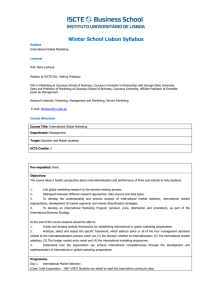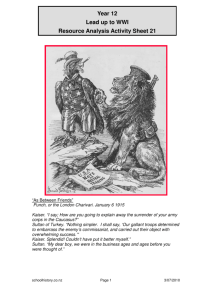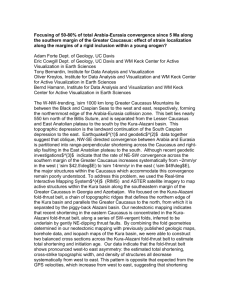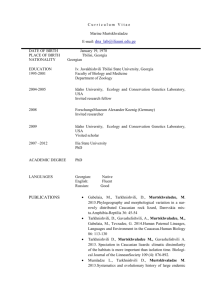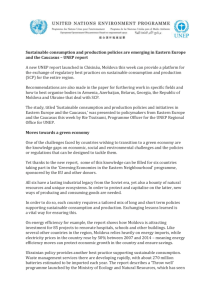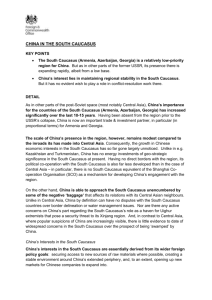INTRODUCTION Thomas S. Szayna and Olga Oliker THE CONTEXT
advertisement
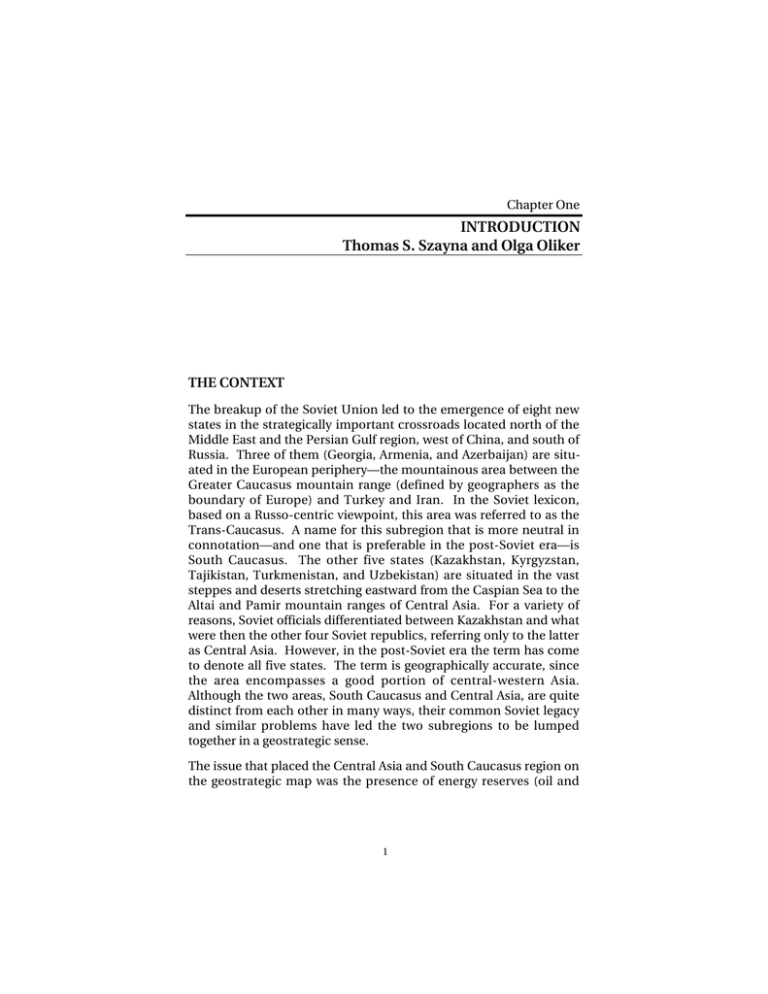
Chapter One INTRODUCTION Thomas S. Szayna and Olga Oliker THE CONTEXT The breakup of the Soviet Union led to the emergence of eight new states in the strategically important crossroads located north of the Middle East and the Persian Gulf region, west of China, and south of Russia. Three of them (Georgia, Armenia, and Azerbaijan) are situated in the European periphery—the mountainous area between the Greater Caucasus mountain range (defined by geographers as the boundary of Europe) and Turkey and Iran. In the Soviet lexicon, based on a Russo-centric viewpoint, this area was referred to as the Trans-Caucasus. A name for this subregion that is more neutral in connotation—and one that is preferable in the post-Soviet era—is South Caucasus. The other five states (Kazakhstan, Kyrgyzstan, Tajikistan, Turkmenistan, and Uzbekistan) are situated in the vast steppes and deserts stretching eastward from the Caspian Sea to the Altai and Pamir mountain ranges of Central Asia. For a variety of reasons, Soviet officials differentiated between Kazakhstan and what were then the other four Soviet republics, referring only to the latter as Central Asia. However, in the post-Soviet era the term has come to denote all five states. The term is geographically accurate, since the area encompasses a good portion of central-western Asia. Although the two areas, South Caucasus and Central Asia, are quite distinct from each other in many ways, their common Soviet legacy and similar problems have led the two subregions to be lumped together in a geostrategic sense. The issue that placed the Central Asia and South Caucasus region on the geostrategic map was the presence of energy reserves (oil and 1 2 Faultlines of Conflict in Central Asia and the South Caucasus gas) of a size that is significant at the global level. Until September 11, 2001, strategic and fossil fuel–driven competition was the central motivation behind any foreign involvement and interest in the area. In fact, competition over how to exploit the resources sharpened in the late 1990s, with disagreements between the United States, the European Union, Russia, and Iran. There were few other reasons for the extensive foreign interest in the area, since the investment climate in the region was not attractive, all of the new states in this region went through a massive decline in the standard of living during the 1990s, and all of them made only a partial (at best) transition to market economies and democratic political systems. The attacks on the United States on September 11 changed the geostrategic context in the region and elevated its importance to the United States. Because of access problems the U.S. military has faced in carrying out combat operations in Afghanistan, the importance of the Central Asian states (especially Uzbekistan) to the United States has grown to a level unimaginable prior to September 11. Based on their own problems with political Islam and the Taliban regime in Afghanistan, some of the Central Asian regimes have been among the staunchest supporters of U.S. combat operations in Afghanistan. If those operations continue, the importance of the region to the United States, as well as U.S. involvement with the states of Central Asia, is bound to grow further. This makes it all the more important to note that all of the states of Central Asia and South Caucasus face a multitude of internal problems that potentially could complicate U.S. relations with them—and U.S. operations on or near their territories. Most of the research effort that led to this report was conducted prior to the September 11 attacks and had the aim of discerning the potential faultlines and catalysts of conflict in South Caucasus and Central Asia internally and in the context of international competition over the manner of exploitation of the area’s energy resources. The launching of U.S. combat operations in Afghanistan and the deployment of U.S. troops to several Central Asian and South Caucasus countries as part of the global war on terrorism have changed the context for U.S. views of the region. They have elevated greatly the strategic importance of Central Asia and South Caucasus to the United States, and security cooperation with some of the countries in the region has increased tremendously. However, all of the faultlines Introduction 3 and catalysts of conflict in the region still remain. The information cutoff date for this report is mid-2002. The Army had an interest in tracking the faultlines in the region because of the emerging rivalry and competition over the area, its remoteness, the relative lack of expertise in the Army regarding the region, and the potential for eventual U.S. military involvement in the area in the long-term perspective. That interest has taken on a new meaning in the post–September 11 security environment. With Army troops on the ground in Central Asia, the need to develop a better awareness of local sensitivities and understand the constraints that U.S. military forces operating in the region might face (including force protection issues) have assumed major importance. OBJECTIVES, APPROACH, AND ORGANIZATION This study began with the goal of seeking to assist the U.S. Army in understanding the operational environment that it may face should it deploy forces to Central Asia and South Caucasus. The September 11 attacks have given the effort greater urgency and importance. The effort had the following key objectives: • Identify and define sources of conflict in the South Caucasus (Armenia, Azerbaijan, and Georgia) and in post-Soviet Central Asia (Kazakhstan, Kyrgyzstan, Tajikistan, Turkmenistan, and Uzbekistan) in the next 10–15 years. • In the 10–15 year time frame, assess the likelihood and ways in which potential conflicts in this region might escalate to a level that could involve U.S. forces, and define the operational environment those forces would face. • Develop intelligence indicators and signposts to forecast crises that could affect Army contingency planning. To address these questions, we proceeded with a multifaceted assessment of the major types of faultlines that may lead to conflict, with each chapter organized around a major potential source of conflict. This report presents the results of that research. Chapter Two focuses on the domestic political realm and traces the political evolution of the region since it gained independence. The 4 Faultlines of Conflict in Central Asia and the South Caucasus problem areas in this category include regime types, extent of participation in the political process, and major political cleavages, which combine with limited economic development to make conflict more likely. The chapter makes use of the political science literature, especially as it pertains to state capacity, democratization, and extralegal forms of participation. The chapter outlines the theoretical background, applies it to the states in question, and then discusses some of the most likely sources of conflict in the near and medium term in greater detail. Chapter Three deals with the economic contributors to conflict and instability in the region. The problem areas in this category include the partial (at best) economic reform, the wide-ranging poverty, external economic dependence, and the specific difficulties stemming from a reliance on the development of one type of extractive industry. The chapter makes use of the literature on development economics and economic liberalization and draws on the author’s decades-long experience with the Soviet economy and more recent studies of this region and its economic development and relationships. Chapter Four tackles the issue of the pervasive presence of organized crime and the drug trade in Central Asia and South Caucasus and its consequences for the political and economic evolution of the region. The chapter addresses the ways in which the criminalization of political and economic life can have positive effects in the short term, especially in societies riddled with the political and economic problems that are present in these countries. In the long term, of course, the effects are pernicious, and greatly increase the risks of economic and political state failure. The indicators and issues are examined both on a state-by-state basis and for the region as a whole. The chapter makes use of the political science literature, especially as it pertains to regime types, and draws on the author’s comparative knowledge of criminalization and international organized crime. Chapter Five deals solely with the issue of exploitation of natural resources in the region. It provides an assessment of the region’s energy and other natural resources and discusses the difficulties inherent in exploiting and transporting these resources, as well as the areas of disagreement between states on these issues. It presents the stark contrasts between the likely “winners” and “losers” in the Introduction 5 future exploitation of these resources and discusses how the development of technology will affect this balance. It discusses possible areas of conflict and also the potential for energy and other resourcerelated infrastructure to become a target for combatants in the event of conflict. The chapter draws on the development economics literature, recent estimates of regional energy resources, and previous work on infrastructure vulnerabilities. Chapter Six focuses on the potential for ethnically based conflict to erupt in the region. Such strife has taken place in the states of Central Asia and South Caucasus during the 1990s, and it is among the most likely types of violence to erupt in the future. The preconditions for violence along ethnic group lines stem from ethnic heterogeneity that is present in most of the countries of the region, combined with an understanding of ethnicity in an ascriptive fashion, politics of ethnic favoritism, regimes inefficient in conflict resolution, high poverty levels and widespread unemployment, and fundamental socioeconomic disruptions that lead to a climate of fear and insecurity. The chapter makes use of the social science literature on ethnicity and politics and, in its predictive portion, refers to a RANDdeveloped model of ethnic conflict. Chapter Seven addresses the issue of foreign interest and competition over the region. It considers the interests in and influence on Central Asia and South Caucasus of a variety of third-party states, including Russia, China, Iran, Turkey, the United States, and Afghanistan, as well as the perspectives of regional states on relations with neighbors and other interested parties. The chapter draws on the political science literature on international relations and international conflict as well as on the work of regional specialists. Chapter Eight deals with the likely operational environment that any Army troops deploying to the region are likely to face. It considers, on a country-by-country and regionwide basis, the issues that terrain, political environment, economic environment, and ecological environment present for operations, the capacities of local states to support force deployments, and the capacities of local military forces to support or oppose U.S. military presence. The particular challenges of moving forces to and through this part of the world are considered in depth. While this is primarily considered in the 10- to 15- 6 Faultlines of Conflict in Central Asia and the South Caucasus year time frame, the chapter also discusses some key issues for the near term. Chapter Nine presents the overall conclusions for the prospects and type of armed conflict in the region, links them to likelihood of U.S. military involvement, and sets out some indicators for intelligence analysts to use in their assessments. It then discusses some of the mitigating factors that work to minimize risk of conflict in the region, although its final assessment is that conflict is likely, and U.S. involvement is increasingly probable. To reiterate, the analysis here takes a long-term perspective, though most of the faultlines described are already in evidence. It is still too early to assess definitively the long-term impact of the U.S. combat operations in Afghanistan on the conflict faultlines described in this report. What is certain is that the faultlines are of a long-term structural nature and will not go away. Thus, the more the United States is involved militarily in this part of the world, the more these factors will challenge and affect its efforts. Furthermore, there is a dynamic interface between U.S. involvement and military presence in Central Asia and South Caucasus and regional developments. Army analysts and planners need to keep the faultlines in mind as they consider options for further involvement in the region.
